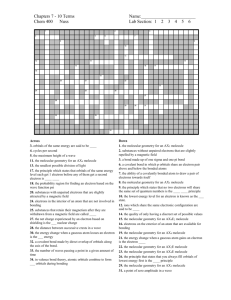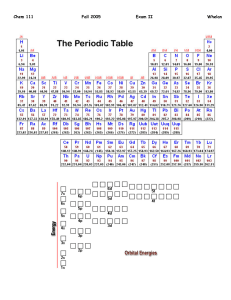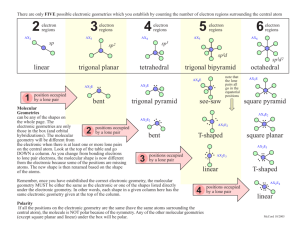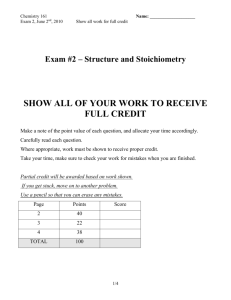presentation source
advertisement
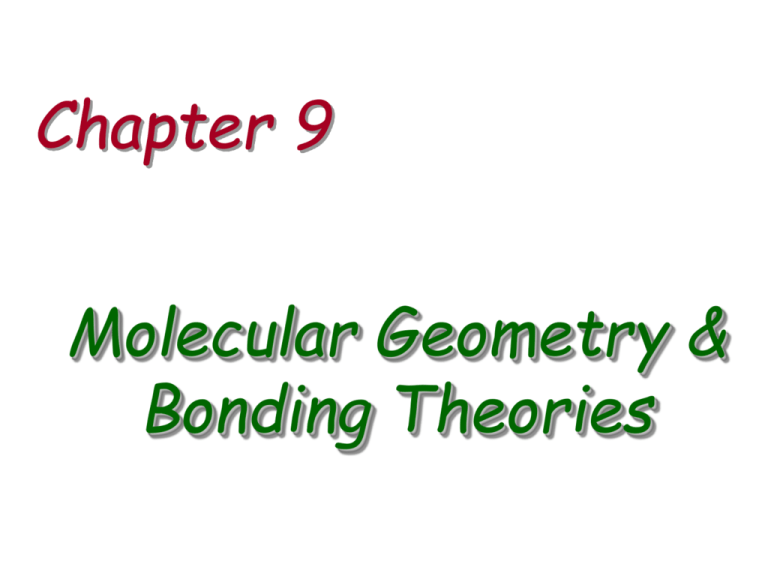
Chapter 9 Molecular Geometry & Bonding Theories Overview Molecular Shapes VSEPR Model Predicting Shapes Effect of Nonbonding Electrons Polarity of Molecules Covalent Bonding Hybrid Orbitals sp, sp2, sp3 hybrids containing d orbitals Multiple Bonds sigma (s) & pi (p) localized & delocalized Molecular Orbitals electron configurations & bond order diamagnetism & paramagnetism Molecular Shapes & VSEPR Shapes defined by bond angles linear, 180° angles trigonal planar, 120° angles tetrahedral, 109.5° angles VSEPR Valence Shell Electron Pair Repulsion theory electron pairs are arranged symmetrically with maximum separation Two electron pairs 180° apart linear geometry 180° •• •• Three electron pairs 120° apart trigonal planar geometry •• •• •• 120° Four electron pairs 109.5° apart tetrahedral geometry •• 109.5° •• •• •• Five electron pairs angles of 90° and 120° trigonal bipyramidal (TBP) geometry •• 120° •• 90° Six electron pairs angles of 90° octahedral geometry •• •• •• 90° Geometries Electron pair geometry arrangement of electron pairs around a central atom Molecular Geometry arrangement of atoms around a central atom When all electron pairs are bonding pairs electron pair geometry = molecular geometry When there are unshared electron pairs electron pair geometry molecular geometry To determine electron pair geometry draw Lewis dot structure count shared & unshared electron pairs around central atom • a multiple bond is counted as only one bonding pair when predicting geometry determine electron pair geometry based on the number of electron pairs • • • • • 2 pair = 3 pair = 4 pair = 5 pair = 6 pair = linear trigonal planar tetrahedral trigonal bipyramidal octahedral Molecular Geometries with One or More Unshared Pairs Two Pairs electron pair geometry linear bonding pairs 2 non-bonding pairs 0 molecular geometry linear Two electron pairs molecular geometry electron pair geometry 180° •• •• Three Pairs electron pair geometry trigonal planar bonding pairs 3 2 non-bonding pairs 0 1 molecular geometry trig. pl. bent Three electron pairs molecular geometry electron pair geometry trigonal planar trigonal planar •• •• •• 120° bent •• Four Pairs electron pair geometry tetrahedral bonding pairs 4 3 2 non-bonding pairs 0 1 2 molecular geometry tet. trig. pyr. bent Four electron pairs tetrahedral molecular geometry electron pair geometry •• trigonal pyramid •• 109.5° •• bent •• •• •• •• Five Pairs electron pair geometry trigonal bipyramid bonding pairs 5 4 3 2 non-bonding pairs 0 1 2 3 molecular geometry tbp seesaw T-shp. Lin. molecular geometry TBP electron pair geometry seesaw 120° 90° •• Five electron pair •• •• •• •• •• T-shaped •• linear •• Six Pairs electron pair geometry octahedral bonding pairs 6 5 4 2 non-bonding pairs 0 1 2 4 molecular geometry oct sq.pyr. sq. pl. lin. Six electron pairs molecular geometry •• •• •• octahedral •• •• square planar •• •• square pyramid •• •• •• electron pair geometry linear 90° Molecular Polarity Molecules are always non-polar if all covalent bonds are non-polar N2, P4, Cl2 Molecules with polar bonds can be polar or nonpolar H - Cl polar bond, polar molecular O=C=O two polar bonds but total molecule is non-polar d+ H Cl d- equal but opposite forces cancel out non-polar molecule d+ d- O C d- O are these dipole moments equal & opposite? d- O d+ H H d+ is this molecule polar? yes no are these bond dipole moments equal & opposite? d- Cl Cl d- yes C d+ d- Cl Cl d- is this molecule polar? no are these bond dipole moments equal & opposite? d+ H H d+ no C d- Cl Cl d- is this molecule polar? yes Single and Multiple Bonds s (sigma) bonds always the first bond between two atoms single bonds are localized between two atoms • orbitals from two atoms overlap, allowing electrons to be shared • electron density is on the internuclear axis •• C localized electrons C p (pi) bonds the second & third bonds between two atoms p bond electrons can be delocalized over several atoms to form resonance structures • electron density is above & below the internuclear axis electron density can move or delocalize •• •• electron density above & below--p bond C C C C C C C C internuclear axis Hybridization allows for greater number of bonds types of hybridization sp mixing of one s orbital & one p orbital • 2s 2p sp sp2 mixing of one s orbital & • 2s 2p sp2 sp3 mixing of one s orbital & • 2s 2p p two p orbitals p three p orbitals sp3 in sp hybridization the two sp hybrid orbitals form two s bonds with linear geometry remaining two p orbitals form p bonds in sp2 hybridization the three hybrid orbitals form three s bonds with trigonal planar geometry the remaining one p orbital forms a p bond in sp3 hybridization the four hybrid orbitals form four s bonds with tetrahedral geometry sp3 hybrid atoms can form no p bonds as they have no unhybridized p orbitals Molecular Orbitals mathematical combinations of atomic orbitals delocalized over whole molecule n atomic orbitals produce n molecular orbitals • ½ are bonding orbitals and ½ are antibonding orbitals bond order # bonding electrons - # antibonding electron 2 electron configuration of diatomic, homonuclear molecules s* p* p s s* s MO’s from p orbital combination MO’s from s orbital combination electron configuration of diatomic, homonuclear molecules with interaction of the 2s and 2p orbitals s* p* s p s* s relative positions switched B.O. = 1 s* s B.O. = 3 s* p* s p s* s H2 2 electrons p* p s* s N2 10 electrons B.O. = 0 s* s B.O. = 2 s* p* p s s* s He2 4 electrons p* p s* s O2 12 electrons

